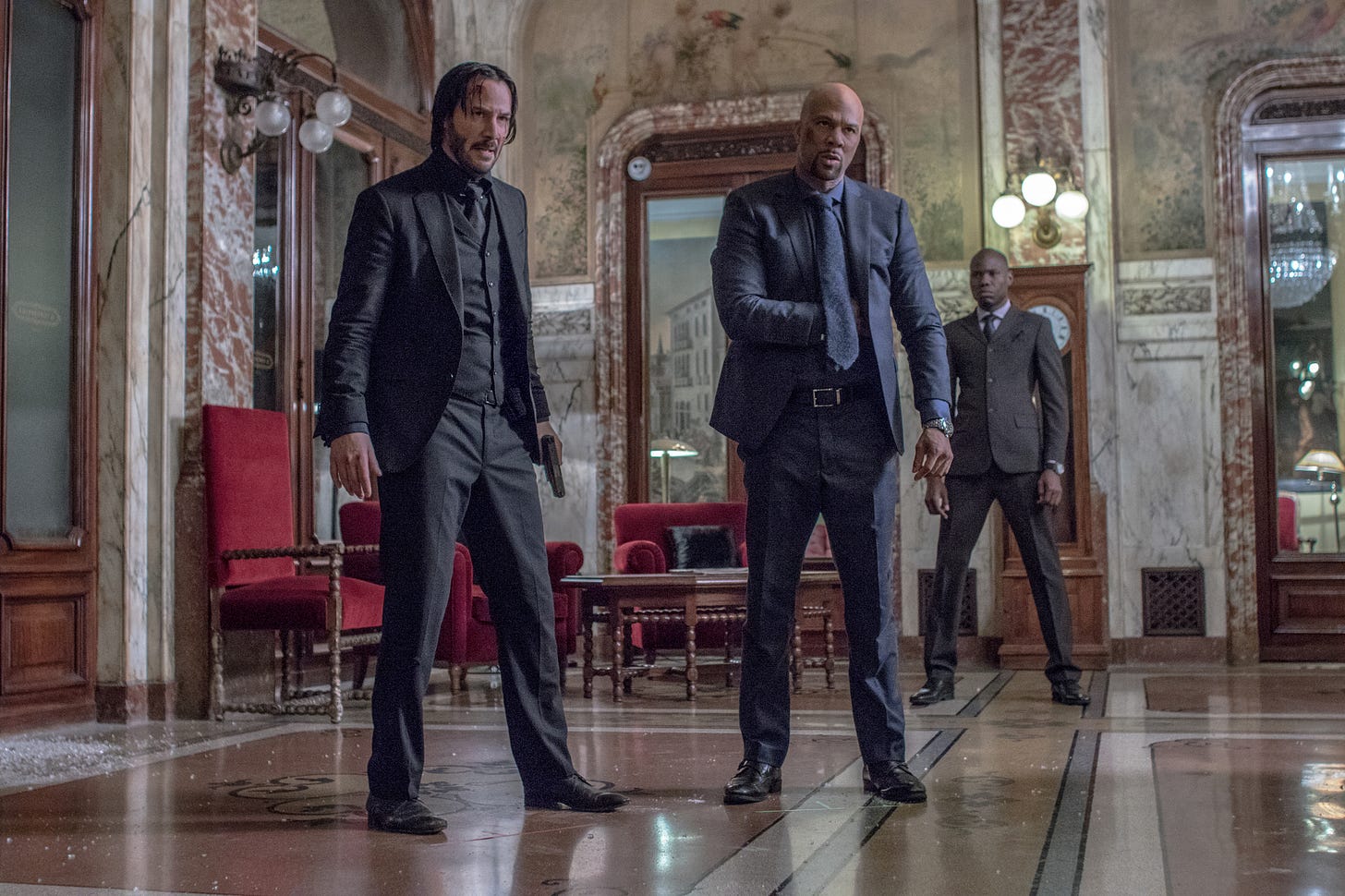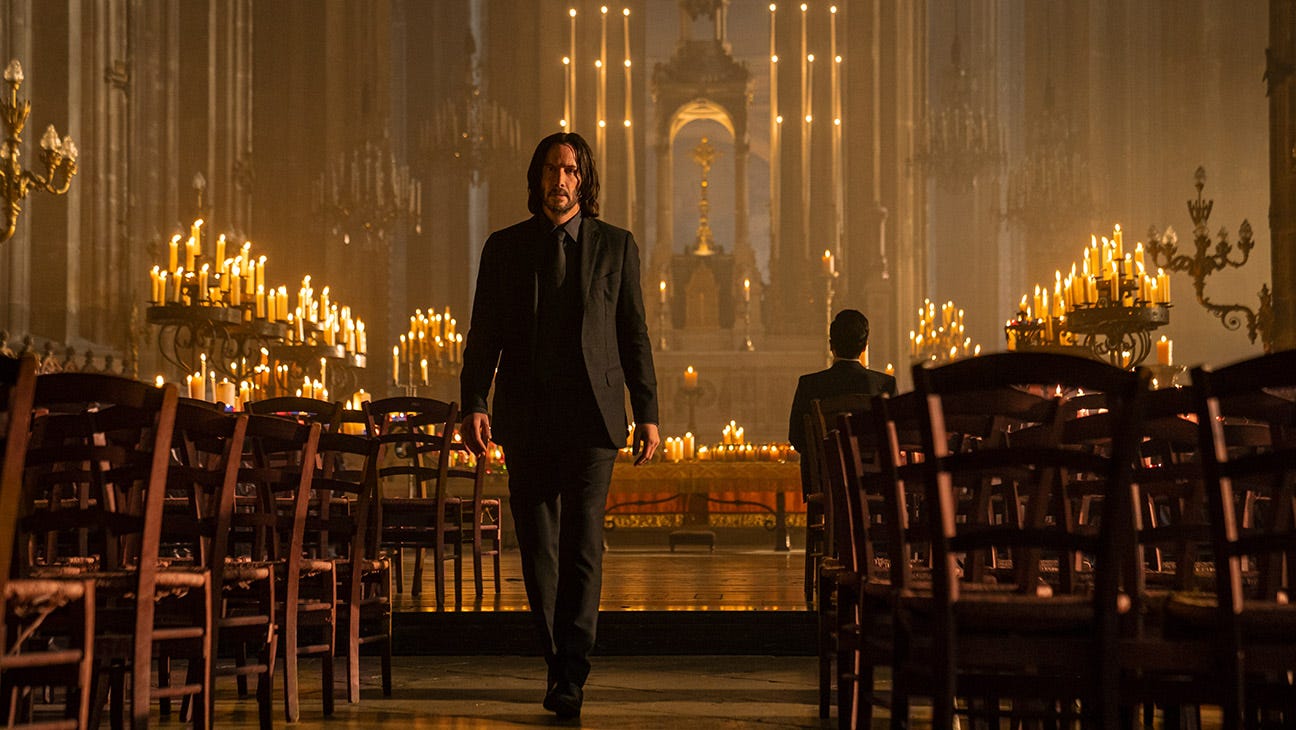The Verdict: The "John Wick" Franchise
With "John Wick: Chapter 4" conquering the box office, I evaluate each film in the franchse.
Welcome to The Verdict, a column in which I group the film and television I’ve been watching into one of three categories: Underrated, Overrated, and Perfectly Rated. This week, I take a look at the John Wick franchise—the epic gun-fu revenge series starring Keanu Reeves.
The John Wick series is the fine wine of modern action cinema. It is one of the few series that seems to have only improved with age, having matured organically from its humble, revenge-fueled beginnings in 2014. The pitch for that first film was a simple one: Let Keanu Reeves star in a 1980s Hong Kong-style action film directed not a conventional filmmaker, but by an actual stuntman—someone who knows how and where to put the camera amid all the explosions and gun violence. (That stuntman is Chad Stahelski, a martial arts aficionado who previously served as Reeves’ body double in The Matrix.) The result, of course, was an incomparable brand of muscle-car gun-fu we didn’t know we needed. No contemporary franchise has quite matched the balletic artistry of John Wick’s long-take action set pieces, its weird mafioso mythology, its sheer inventiveness in the act of killing.
John Wick: Chapter 4 has conquered the box office since its release last weekend, taking a total of $146 million worldwide, and only looks to grow from there. It’s a wonderful reminder that action cinema doesn’t just have to be Marvel movies with incomprehensible CGI, but rather something with veritable talent and creativity. It’s something that deserves appreciation, so with this entry into The Verdict, I thought I might take the time to look back at a series that has bred an entire generation of cinema nerds to appreciate action filmmaking as one would a glass of fine merlot.
Underrated: John Wick: Chapter 2
Compared to more recent films in the franchise, John Wick: Chapter 2 keeps it simple. There is no scrutinization of the High Table and its deep mythology, no winking self-referential gags to the audience. Like the first film, Chapter 2 is about a reluctant hero pulled back into a world that he seeks to escape, and it’s awesome. Keanu is at his most knife-jawed and growly in this film; his stuntwork is as gracefully violent as ever. Chad Stahelski’s direction maintains a desolate tone that keeps the action feeling punchy and brutal, as in an eight-minute fight scene that involves a subway, silenced pistols, and deadly pencils. It’s the best sequence in the film, and my favorite of the entire series.
John Wick: Chapter 2 also features Cassian, my favorite gun-wielder in the entire franchise (or at least that was the case until Chapter 4 came out). Cassian, John’s friend and fellow assassin, is played by the rap artist Common, who imbues his character with a stoic anger that makes him feel genuinely threatening. Other great performances in Chapter 2 include Laurence Fishburne as The Bowery King, an underground crime lord with a network of undercover “homeless” criminals, and Peter Serafinowicz as The Sommelier, an oh-so-posh international weapons supplier. Chapter 2 isn’t quite a forgotten gem, but when considered within other, more bombastic entries in the series, I find that it gets overlooked.
This is especially true in the case of…
Overrated: John Wick: Chapter 3 — Parabellum
The John Wick film with the wordiest title is also its worst, which is not to say that it is bad. There is still some magnificent fight choreography, especially in a staggering opening sequence that begins with an NBA player literally dying by the book, continues onto a beautifully violent knife-throwing competition, then finally putting Keanu on horseback for some good old horse-fu. Put back-to-back, one might consider this the single greatest sequence that the series has ever produced. (That is, until Chapter 4 came out. More on that soon.)
Still, Chapter 3 is also the entry in the series that is the most frustraingly infatuated with The High Table and its sprawling mythology. There film introduces ritual after ritual, rule after rule, none of which add up to much in terms of the film’s emotional heft. There is a subplot involving an “Adjudicator” and the “deconsecration” of the New York continental, a subplot about an Elder who sits above The High Table, a subplot involving a woman from John’s past who owes him a debt. Each of these is less interesting than the last, making the fatal mistake of distracting is from what matters most: John Wick, in a suit, shooting bad guys.
Speaking of which…
Perfectly Rated: John Wick
John Wick is about John Wick, in a suit, shooting bad guys. And it f*cking rules. Like its protagonist, this film is simple and effective. John Wick, ex-assassin and boogeyman-killer extraordinaire, is pulled out of retirement after Russian mobsters kill his dog—a dog that was gifted to John by his recently-deceased wife. John is set on a quest for revenge, leading to a series of hyper-stylized action sequences set in an equall stylized world filled with international crime syndicates.
John Wick was the perfect comeback role for Reeves, a silent film star born after his time. With an inscrutable face that belies a potent physicality, Reeves elevates the film, embodying his action stardom by throwing his own punches and doing his own stunts. The film’s ultraviolent brutality would never have felt as crunchy without him. The same could be said of director Chad Stahelski, who brings the kind of detailed precision you would expect of a longtime stunt coordinator. Rather than shaky-cams and CGI, Stahelski shoots John Wick with a stable long-takes that allow his actors and stuntment to put their talents on display.
It is also worth mentioning the film’s excellent side characters, most notably Ian McShane as the undaunted manager of the New York Continental and Lance Reddick (RIP) as Charon, the hotel’s welcoming concierge. Both of them helped set the series’ alternately serious and slapstick tone, with performances that tapped into a subtle humor that never tipped over the edge.
Perfectly Rated: John Wick: Chapter 4
Many have argued that this most recent entry into the John Wick franchise is actually its best. Rightly so. It is an honest-to-god action epic, with damn near three hours of explosive physical combat that is more impressive than anything the series has done thus far. It traverses the globe in exhilirating fashion, moving from New York to Osaka to Berlin to Paris; each locale is as gloriously shot as the last. It is also the first film in the series to tap into the emotional potency of the samurai-hitman mythos, with numerous dramatic conversations about “where all this killing will end” set amid the backdrop of a Japanese cherry blossom garden, or at the base of the Sacré-Coeur. These conversations aren’t exactly transcendental, but they don’t need to be. This is John Wick, after all.
I mentioned earlier that Cassian was my favorite gun-wielder in the franchise until this film, and that’s because Chapter 4 by far features the best all-around cast in the entire series. Hong Kong action legend Donnie Yen plays Caine, a blind assassin who fluctuates between trying to save and murder our protagonist; Yen gets the funniest and most consistent laugh lines in the entire series. Shamier Anderson plays Mr. Nobody, a shotgun-wielding “tracker” with a Wick-like love for dogs; Anderson comes across as a born action star. Japanese martial artist Hiroyuki Sanada plays Koji, the samurai manager of the Osaka Continental; popstar Rina Sawayama plays his daughter Akira, a knife-wielding badass.
Bill Skarsgård is worthy of specific mention. He here plays the film’s villain: the Marquis Vincent de Gramont, an exceptionally pompous Frenchman, a noble élite who sports diamond-studded suits and watches dressage competitions in his spare time. Skarsgård, a Swede, manages to make the Marquis feel as bombastically, stereotypically French as he can be, and it works. He is the perfect foil to John Wick: Where John is self-reliant, self-built, and driven by personal vengeance, the Marquis is dependent on mafioso structures, borne of inherited wealth, and driven by a desire for power. It’s a perfect contrast, and Skarsgård’s melodramatic expressions help the film balance farcical comedy with punishing drama.
And good lord, the action sequences. Within the first twenty minutes, Keanu Reeves has ridden on horseback across Aqaba (Lawrence of Arabia style) and fought Donnie Yen using nunchuks. Later, there is a neon-drenched set piece set inside a Berlin nightclub, with shimmering waterfalls and club rats who keep dancing amid the murderous violence. The film concludes in a 40-minute+ sequence set in Paris that will surely go down as among the most grueling, punishing, and singularly rewarding action cinema sequences ever put on film. We watch as John Wick, ever the glutton for punishment, tries endlessly and without fail to climb the Sacré-Coeur’s 222 steps amid a $40 million bounty and hundreds upon hundreds of bad guys. Reeves and Stahelski, an incredible star-director duo, turn this sequence into a masterwork.
John Wick: Chapter 4 is a far cry from the first John Wick film, and that’s OK. The series has grown and adapted with the years, ending up in a place that is equal parts gun-fu as it is Buster Keaton. Keanu Reeves, now a 58-year-old man, should now be in consideration as one of the great action stars of all time, if he wasn’t already. This series is a testament to his abilities.
Agree or disagree with these takes? Have any underrated/overrated takes of your own? Let me know in the comments!







